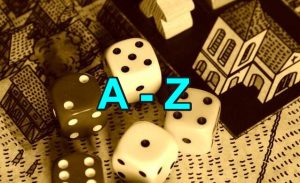 There are a few words and terms that are specific to playing board games. These can be helpful to know if you’re new to the hobby, or just want to sound like a pro!
There are a few words and terms that are specific to playing board games. These can be helpful to know if you’re new to the hobby, or just want to sound like a pro!
Here is an alphabetical list of some of the most common words and phrases used when playing board games.
Action Points:
Action points are a common mechanics in board games. They represent the amount of energy or action a player has to spend on their turn. For example, a player may have two action points, which they can use to move their character, pick up an object or perform another action. Once all of their action points are used up, the player’s turn ends . Action points are often replenished at the start of each turn. Games with action points include Twilight Struggle and StarCraft: The Board Game.
Try playing:
Pandemic Legacy: Season 1
Throught the ages: A new story of civilisation
Arkham Horror: The card game
Blood Rage
Pax Pamir: Second edition
Area control/movement:
In an area control game, players compete for control of different areas on the board. The most famous area control game is Risk, but there are many others, like Twilight Imperium.
Try playing:
Star Wars: Rebellion
Auction:
Many board games involve some form of auction, where players bid against each other for items or resources using in-game currency.
Bluffing:
Bluffing is a popular mechanic in board games, where players attempt to deceive their opponents about the strength of their hand or position.
Cards:
Used in a wide variety of board games for all kinds of purposes. Cards are often used as a way to add randomness to a game, or as a way to keep track of information.
Deck-building:
Deck-building games are a popular genre, in which players start with a small deck of cards and must expand it throughout the course of the game. The most famous deck-building game is probably Dominion, but there are many others.
Dice:
Used in many board games to add an element of chance. Dice come in all sorts of different sizes and shapes, and can have different numbers of sides.
Dice tower:
This is a device that is used to rolled dice in a controlled way, so that they don’t end up going all over the place.
Grid movement:
Grid movement refers to games in which players move their pieces along a grid (like a chessboard). Many strategy games use grid movement, such as Paths of Glory and Twilight Struggle
Meeples:
Small wooden figures that are often used as player pieces in board games. The term was coined by German game designer Klaus Teuber for his game Carcassonne, where they represented farmers, knights and other characters. Nowadays, meeples are used in all sorts of games and can represent anything from animals to aliens! The term “meeple” is a combination of “my” and “people,” and was first coined by British game designer Alison Hansel.
Pawns:
Another type of small figure that is often used as a player piece in board games. Pawns are generally more basic than meeples, and are often used in chess-like games. They are typically represented by small plastic or metal figures. Unlike meeples, pawns usually have a set starting point and limited movement options.
Set collection:
In games with a set collection goal, players must collect certain items, usually cards, in order to win the game. The popular card game Dominion and the classic card game Rummy are prime examples of set collection games.
Spaces:
The areas on the board where players can move their pieces. Different games will use different numbers of spaces, and they can be arranged in all sorts of different ways.
Tableau:
A term used to describe the layout of cards in games such as 7 Wonders and Race for the Galaxy.
Tiles:
Often used in place of spaces in board games. Tiles are usually square, and can be placed next to each other to create all kinds of different shapes and patterns.
Tile laying:
This refers to a type of gameplay where players place tiles on the board in order to create paths or other structures. The classic game of Mahjong is a tile-laying game.
Token:
A small disc or piece that represents something in the game, such as money or victory points.
Victory points:
Victory points are how many “points” a player has in the game, and the player with the most victory points at the end of the game is the winner. Many games use victory points , including the popular board game Settlers of Catan.
Worker placement:
A type of game where players place their pieces on different spaces on the board in order to take various actions, as seen in games like Agricola and Le Havre.
Zoning:
In many games, players must divide up the board into different areas, or “zones”. Each zone may have its own rules, and players must carefully plan their moves in order to take control of the most strategic areas.
These are just a few of the many terms you’ll come across when playing board games. By familiarizing yourself with them, you’ll be able to jump into any game with confidence. Happy gaming!

